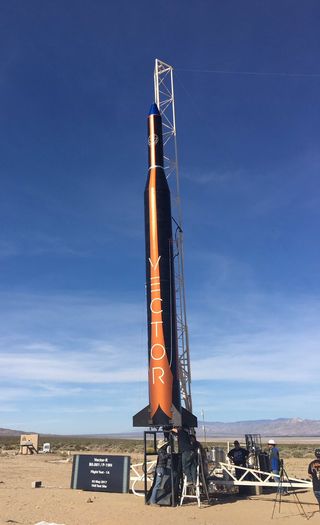Vector Space Makes 1st Test Launch of Small-Satellite Rocket

A small rocket built to carry especially small payloads into space made its first test flight today (May 3) from Mojave, California.
The commercial launch provider Vector Space Systems successfully launched an engineering model of the company's Vector-R launch vehicle shortly after 12:00 p.m. PDT (3:00 p.m. EDT/1900 GMT) from the Friends of Amateur Rocketry (FAR) site in Mojave, California. The model consisted of the Vector-R first-stage engine and a 3D-printed injector. The rocket was scheduled to reach an altitude of 4,500 feet (1,370 meters).
The Vector-R rocket is designed to fly payloads of up to 130 lbs. (60 kilograms) to low-Earth orbit, which makes the vehicle ideal for launching "microsatellites," a subclass of small satellites that weigh between 22 and 220 lbs. (10 and 100 kg), according to NASA. The company plans to begin commercial launches in 2018, and is scheduled to conduct an additional test flight this summer. [Vector Space Tests Rocket Tech for Microsatellite Launches | Video]
"2017 has already been a ground-breaking year for Vector as we continue testing full-scale vehicle engineering models to demonstrate functionality and flight operations," Jim Cantrell, Vector co-founder and CEO, said in a company news release. "The success of this test not only sets the standard for the swift mobile development of our launch vehicles, but also furthers our mission to revolutionize the spaceflight industry and increase speed to orbit."

Small satellites
The capabilities of small satellites — such as cubesats, some of which are about the size of a lunchbox — is rapidly increasing, with companies and space agencies interested in using the bantam craft for applications such as Earth imaging and communications. But these small satellites typically get to space by "piggybacking" on large payloads sent to space by massive rockets. Companies like Vector want to make it possible for small-satellite operators to send those payloads into space more frequently and independent of larger payloads.
"Vector is the first launch vehicle built exclusively for the microsatellite market," according to the company website. "This vehicle is 'right-sized' for the new generation of microsatellites and enables reliable and frequent access to orbit."
The company plans to make 12 commercial launches with the Vector-R in 2019, and as many as 100 per year at full launch capacity. Vector is also working on the Vector-H (Vector Heavy) rocket that will carry payloads of up to 275 lbs. (125 kg) to low-Earth orbit. Vector recently announced it plans to launch the Vector-R from Launch Complex 46 (LC 46) at Cape Canaveral Air Force Station in Florida, which is operated by Space Florida, a state-backed economic development agency.
Get the Space.com Newsletter
Breaking space news, the latest updates on rocket launches, skywatching events and more!
3D-printed parts
Vector developed its 3D-printed engine injector with help from NASA. The company won a grant from NASA's Science, Technology and Mission Directorate (STMD) Flight Opportunities program, which "extends [NASA] research labs into space-relevant environments by partnering with small satellite launch companies," according to a news release from Vector.
The grant allowed Vector to design and test the single-piece injector, which was created using a technique called additive manufacturing (also known as 3D printing). Instead of manufacturing different pieces of the injector and then attaching them to the finished instrument, the additive- manufacturing approach allows the production of the injector as a single piece of hardware.
"With this successful in-flight operation of an additively manufactured injector, we have now moved the maturity of this technology to the next level for small launch vehicles," John Peugeot, project manager for 3D additive manufacturing (AM), who is working with Vector on its injector, said in the news release regarding today's test flight. "This represents a critical step in moving AM hardware beyond laboratory testing and toward qualification for real-world applications."
Follow Calla Cofield @callacofield. Follow us @Spacedotcom, Facebook and Google+. Original article on Space.com.
Join our Space Forums to keep talking space on the latest missions, night sky and more! And if you have a news tip, correction or comment, let us know at: community@space.com.

Calla Cofield joined Space.com's crew in October 2014. She enjoys writing about black holes, exploding stars, ripples in space-time, science in comic books, and all the mysteries of the cosmos. Prior to joining Space.com Calla worked as a freelance writer, with her work appearing in APS News, Symmetry magazine, Scientific American, Nature News, Physics World, and others. From 2010 to 2014 she was a producer for The Physics Central Podcast. Previously, Calla worked at the American Museum of Natural History in New York City (hands down the best office building ever) and SLAC National Accelerator Laboratory in California. Calla studied physics at the University of Massachusetts, Amherst and is originally from Sandy, Utah. In 2018, Calla left Space.com to join NASA's Jet Propulsion Laboratory media team where she oversees astronomy, physics, exoplanets and the Cold Atom Lab mission. She has been underground at three of the largest particle accelerators in the world and would really like to know what the heck dark matter is. Contact Calla via: E-Mail – Twitter
Most Popular


